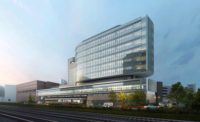With COVID-19 cases rising across the country last spring, Philadelphia health care providers braced for horror. Despite uncertainties, Kevin Mahoney, CEO of the University of Pennsylvania Health System, looked to increase bed capacity on the West Philadelphia campus of the Hospital of the University of Pennsylvania. In mid-March, Mahoney asked for help from the project team on the $1.5-billion Pavilion at the Hospital of the University of Pennsylvania. “Our CEO called me and asked how many rooms we could give him in 10 days,” recalls Steve Greulich, associate vice president of capital projects at UPHS, also known as Penn Medicine. “He gave us 24 hours to figure it out.”
Greulich and the team came back with four options with various time frames and bed deliveries. Ultimately, Mahoney and the team chose the path that would provide 119 non-acute beds in 20 days—15 months ahead of schedule. By providing non-acute beds in the Pavilion, Penn Medicine could free up other hospital beds on campus that were better equipped to handle COVID patients.
Although Mahoney’s ask was bold, it was informed. Mahoney had taken the CEO role just a year earlier, but he had held various leadership positions at Penn Medicine for 24 years and was involved on multiple large capital projects within the health system. While initial planning for the Pavilion was underway in 2012, Mahoney, who was chief administrative officer at the time, suggested using integrated project delivery. Despite significant resistance to applying the alternative delivery method for the first time in Penn Medicine history on what would be the institution’s largest capital project ever, Mahoney held firm. “Penn is a pretty conservative institution when it comes to legal and risk management,” Greulich says. “If Kevin hadn’t held positions at Penn for about 15 years at that point and had the level of experience he had, I doubt that IPD would have happened.”
Greulich says the use of IPD on the project helped create a level of collaboration and teamwork not typically seen on traditional projects. So, when Mahoney turned to the team for help, they were well positioned to answer. “My first reaction when he asked [to deliver beds early] was that, if he’s asking for it, he believes it can be done—and if he believes it, I’ll do everything I can to make it happen,” says Mack Stulb, president of L.F. Driscoll, which is part of the IPD team along with construction manager Balfour Beatty, designers HDR and Foster+Partners, and engineers BR+A and Southland Industries. “He’s inspirational. He’s all about changing medicine, helping patients and saving lives.”
After the team successfully expedited the beds, the number of cases in the city began to drop heading into the summer. Construction is now moving ahead for 2021 delivery, as planned. But, if the need for additional beds arises again, Greulich says he knows the team can respond quickly. “There’s no intention to do so, but certainly, we could if we need to.”






Post a comment to this article
Report Abusive Comment